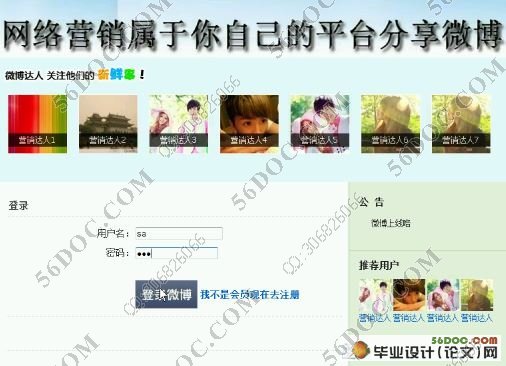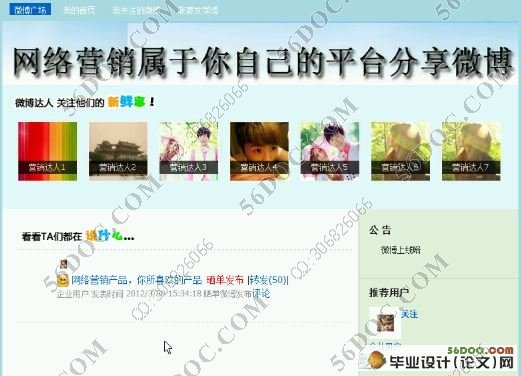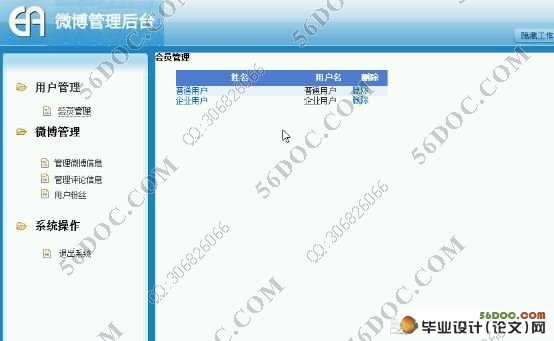微博营销系统的设计与实现(含录像)
无需注册登录,支付后按照提示操作即可获取该资料.
微博营销系统的设计与实现(含录像)
[摘要]:利用微博这种网络应用形式开展网络营销的工具,是公司或者企业利用微博这种网络交互性平台,发布并更新企业或公司的相关概况及信息,并且密切关注并及时回复平台上客户对于企业的相关疑问以及咨询,并通过较强的微博平台帮助企业或公司零成本获得搜索引擎的较前排位,以达到宣传目的的营销手段,对企业在电子商务环境下开展网络营销与其他网络营销手段相比有着独特的应用价值。尽管微博已成为一种新型的网络营销手段。本系统的中心旨利用.net开发平台将微博营销运用到实际中去,符合企业产品的宣传理念
关键词:网络应用;网络营销;网络宣传;.NET平台
[ Abstract ] : the use of micro-blog this application form to carry out network marketing tool, is the company or the enterprise use the micro-blog this kind of network interactive platform, publish and update the enterprise or company's related situation and information, and pay close attention to and the prompt reply platform for enterprise customers related questions and advice, and through strong micro-blog platform help enterprise or company zero cost to obtain the search engine ranking than before, in order to achieve the aim of propaganda means of marketing, enterprises in the environment of electronic commerce network marketing and other means of network marketing has a unique application value. Despite the micro-blog has become a kind of new network marketing means. The purpose of the system development using.Net platform will be center of micro-blog marketing to use to practice, enterprise products in line with the concept of propaganda
Key words: network; network marketing; network information; the. NET platform
微博营销主要是针对企业发布的信息进行宣传推广。
其开发主要包括后台数据库的建立和维护以及前端应用程序的开发两个方面。对于前者要求建立起数据一致性和完整性强、数据安全性好的数据库。而对于后者则要求应用程序功能完备,易使用等特点。
微博营销系统将操作角色管理员;管理员操作用户管理,微博统计,用户粉丝统计,评论统计
系统总体功能
依照系统的业务分工和经营流程,本系统主要分为字典维护、微博统计、评论管理、用户管理、粉丝管理
字典维护主要用于设置系统的字典信息,对系统的相关信息进行设置。
字典维护
字典维护模块主要用于设置各类基本信息,包括微博信息、评论信息、粉丝统计、用户信息。
微博信息用于设置微博的基本信息,微博标题,微博内容。发布人,发布时间
评论信息用于设置微博各项的基本信息,其属性包括评论标题,评论内容,评论时间
粉丝管理用于设置用户的被关注情况信息。
用户管理用于设置用户的基本情况信息。




目录
1.1 系统开发的背景和意义 1
1.2 开发环境 1
1.2.1 .NET简介 1
1.2.2 Microsoft SQL Server 2000简介 1
2.系统的总体设计 2
2.1 需求分析 3
2.1.1 操作系统 3
2.1.2 面向对象 3
2.1.3 微博管理 5
2.1.4 评论管理 5
2.1.5 粉丝管理 5
2.1.6 用户管理 5
2.2 模块功能设计 5
2.2.1 系统总体功能 5
2.2.2 字典维护 5
2.2.3 微博管理 6
2.2.4 评论管理 6
2.2.5 粉丝管理 6
2.2.6 用户管理 6
3. 详细设计 7
3.1 数据表 7
3.2 存储过程 9
3.2.1 存储过程概述 9
3.3 触发器 10
3.3.1 触发器概述 10
4. 实现系统框架 11
4.2 系统登录 11
4.3 系统主界面 11
4.3.1 主框架页面 11
4.3.2 系统前台页面框架 12
5. 字典维护模块 12
5.1 微博信息 13
5.2 用户管理 14
6.测试分析报告 16
6.1 测试计划和要点 16
6.1.1 字典维护测试要点 16
6.1.2 信息管理测试要点 16
6.1.3 运单管理模块测试要点 17
6.2 测试用例 17
6.2.1 字典维护模块测试用例 17
6.2.2 运单管理模块测试用例 17
6.3 测试结果及结论 18
6.3.1 测试的结果 18
6.3.2 缺陷分析及改进 18
6.3.3 测试结论 19
结论及存在问题 20
致谢 21
参考文献 22
